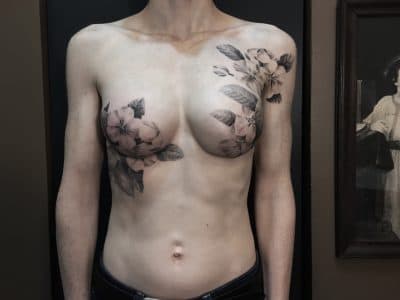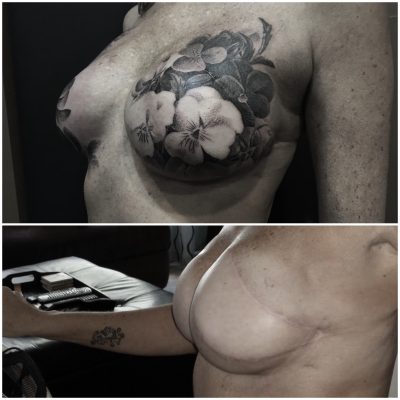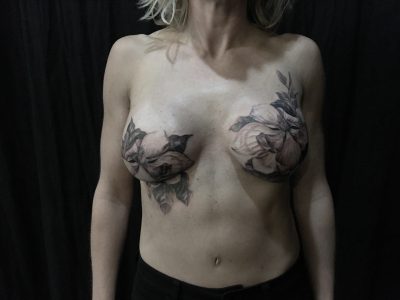Advertisement
'Reclaiming Their Beauty': Tattoo Artist Inks Exquisite Flowers Over Mastectomy Scars
The first time a woman approached tattoo artist David Allen and asked him to hide her mastectomy scars, he says he "politely declined."
He’d had surgery himself, and knew that scar tissue isn't the same — it's not as pliable or elastic, and may not heal as well. "I was hesitant to mess with the scarring," he says. But the woman kept asking, and after some research he agreed.

"It changed me. The gravity of the situation, watching her change," Allen says. "The way she carried herself, her posture. Her smile, her joy were infectious. I couldn’t believe I was able to use my craft to have that kind of influence."
That was seven years ago. Since then, the Chicago tattooer (as the former painter prefers to be called) has applied his artistry to more than 70 women who’ve undergone mastectomy and breast reconstruction.
Allen now takes on five or six clients a month. Most of them have been over 50 years old.
When he’s done, their reconstructed breasts and the surrounding area bloom with graceful flowers, branches and leaves. The scars are still there, but it almost seems as though they’ve been erased, or at least supplanted, by Allen’s pointillist tattoo artistry.
He says his clients are "trying to reclaim their beauty."
Recently Allen’s work got prominent notice in an unexpected place -- JAMA, the leading medical journal of the American Medical Association. The journal invited him to write on "the healing role of post-mastectomy tattoos" for its big audience of doctors and other caregivers.
"It got tremendous viewing from the very beginning," says Roxanne Young, who edits JAMA’s "Art and Medicine" section. "Mr. Allen’s article has been the highest for this particular feature ever. So far there have been 62,000 views."
Advertisement
The response, Young says, has been uniformly positive — even though JAMA published graphic before-and-after images of Allen’s clients. “It’s always risky to publish the naked body in some form with some readers, including physicians,” she reports. “I haven’t seen anything along those lines from our readers — and believe me, they would comment.”
The tweets tell the story. “Beautiful work by an #artist to empower #breastcancer #survivors,” wrote one Twitter user. “What a beautiful way to reclaim your body post-mastectomy,” wrote another. One Tweeter wrote: “David Allen = amazing. Maybe it will help someone who’s had a mastectomy.”
Dr. Kevin Hughes, co-director of Massachusetts General Hospital’s Avon Comprehensive Breast Evaluation Center, voices a common reaction: "[Allen] seems very thoughtful in making sure this is what a woman wants to do – not just a reaction to surgery or an overnight whim,” Hughes said in a phone interview. “He puts a lot of thought into what he’s doing.”
What shines through in Allen’s words, in the JAMA article and a lengthy interview, is a deep respect for his clients. Before he picks up the tattoo needles, he elicits their stories, probes their expectations, and listens intently.
“I spend more time talking to them than actually working on them. I ask hundreds of questions. I need to know that they’re ready."
“I spend more time talking to them than actually working on them,” he says. “I ask hundreds of questions. I need to know that they’re ready."
“Some women don’t know what they want,” he wrote in JAMA, “which means I can’t be certain that what I do will help them, or they want to regain control by controlling me, which doesn’t work since it inhibits my freedom to help them. Some are managing disagreements with family members about the appropriateness of what I do.”
He’s found that some of his post-mastectomy clients feel deep rejection. “Their husbands often don’t want to touch them,” he says. “They see them as victims.”
One woman flew to Chicago from the East Coast seeking Allen’s services. But she burst into tears when he first touched her. Her husband had left her after she developed breast cancer and no man had touched her in years.

Allen couldn’t go ahead with the tattoo. "I told her, 'I don’t think you’re ready,'" he says. "She was actually grateful that I gave her an out — that she didn’t have to decide right then." She later returned after working through her emotional pain.
For women who are clear about wanting Allen’s brand of tattooing, it appears to be, beyond the cosmetic result, a way of asserting themselves in the face of loss. "There’s an element of tattoos that people don’t talk about — control," he says. "To regain control or take control. It’s a drastic measure you can take for yourself that alters you."
Most of his clients stay in touch. "Some women are proud of their change and want to show the world their transformed chest," he reports. "Others feel re-sexualized by the imagery and carry themselves more confidently, while others feel the change deeply, but quietly, and keep it private."
Post-mastectomy tattooing is not new. Occasionally, women who’ve chosen not to have breast reconstruction have decorative tattoos applied to their flat chests. And commonly, women who have had to have their nipples removed because they were too close to cancerous tissue, have what’s called "micropigmentation." That’s a trompe l’oeil or “fool-the-eye” tattoo that mimics the coloration of the missing aureola and nipple.
Such artistry can be very effective, but to Allen’s eye, it's not convincing. "There’s no dimension to it. And the color fades over time, actually."
That’s one reason Allen uses only black pigments to produce his delicate botanical images, which, against women’s flesh tones, have the flavor of Japanese scroll paintings.
"There is a higher level of finesse" than most tattoos, Allen says. "I need to be more thoughtful and gentle."
For instance, he uses three tiny needles pointed at a single location and a quiet, lightweight tattoo machine that oscillates around 40 times per second. Conventional tattoos are done with anywhere from 7 to 45 needles to lay down a swath of pigment. He holds the device in one hand while stretching the skin taut, using variations in the vibrations of the skin to gauge how deep the needles are going.
How painful is the process? "I’d say 60 percent of the time they can barely feel it, it’s like a pinch," Allen says.

Like most women who've had breast reconstruction, the great majority of Allen's clients have had implants, a procedure that severs many nerve endings and renders the area mostly numb. (The rest have reconstructions using their own tissue, a procedure in which nerves are reattached.) In areas that are not numb, Allen says, there is pain, which he estimates as about a seven on a 10-point scale. “In my experience, women can handle tattoo pain better than men,” he says. “A lot of it is in how you wrap your head around it.”
One reason he declines to go ahead if he senses a woman is ambivalent or struggling with emotional issues is that “if you’re too emotional, you don’t handle pain well.”
He doesn’t use topical anesthetics because “it affects how the skin responds, and that [response] is how you know how you’re doing.”
Typically, application of the tattoos (not counting the interview process and design selection) requires three to five hours. He charges between $1,000 and $2,200 for the whole process.
Allen knows of some other tattooers who have begun to specialize in post-mastectomy clients, but not many. “Some of the top talents in the tattooing world don’t mess with this,” he says. “They don’t want to. It’s scary. There’s emotional weight, and also it doesn’t pay as much.” He declines to refer clients to others if he can’t take them on because “even if the look is good, I don’t know about their bedside manner.”
He's beginning to work with breast surgeons and plastic surgeons to come up with a more systematic approach to helping women decide if his brand of tattooing is for them, and to educate clinicians about what he does.
But for now, women who want to explore this option will probably have a hard time finding someone like Allen, if they can’t get on to his waiting list or go to Chicago.
That may change if the demand increases, but Dr. Constance Chen, a New York City plastic surgeon who specializes in post-mastectomy reconstruction, doesn’t foresee a rush to the type of masking tattoos that Allen does.
Chen likes Allen’s approach as one option; she sees it as “making lemonade out of lemons.” But she thinks only a small subset of post-mastectomy patients will choose it.
“My strong feeling is that a woman’s body is her own and she should be able to decide what she wants to do with it,” Chen says. “But if you’re having a tattoo across your chest, it’s certainly a statement, not something anyone can ignore. And I think most women would want to look ‘normal’ and not have a conversation about their bodies every time they’re in a locker room or a dressing room.
“So should it be offered as an option? Sure,” Chen says. “But am I worried that there won’t be enough tattoo artists? No, I’m not.”